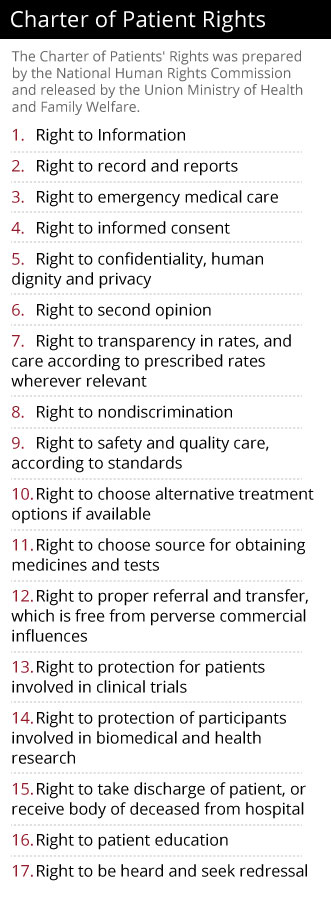
- Home
- News
- Analysis
- States
- Perspective
- Videos
- Education
- Entertainment
- Elections
- World Cup 2023
- Features
- Health
- Business
- Series
- Economy Series
- Earth Day
- Kashmir’s Frozen Turbulence
- India@75
- The legend of Ramjanmabhoomi
- Liberalisation@30
- How to tame a dragon
- Celebrating biodiversity
- Farm Matters
- 50 days of solitude
- Bringing Migrants Home
- Budget 2020
- Jharkhand Votes
- The Federal Investigates
- The Federal Impact
- Vanishing Sand
- Gandhi @ 150
- Andhra Today
- Field report
- Operation Gulmarg
- Pandemic @1 Mn in India
- The Federal Year-End
- The Zero Year
- Premium
- Science
- Brand studio
- Home
- NewsNews
- Analysis
- StatesStates
- PerspectivePerspective
- VideosVideos
- Entertainment
- ElectionsElections
- Sports
- Loading...
Sports - Features
- BusinessBusiness
- Premium
- Loading...
Premium

Difficult to diagnose: What doctors say, what patients hear

When 50-year-old Chandra from Chennai was diagnosed with a cyst in one of her kidneys, she expected her nephrologist to give her a detailed account of the prognosis or the likely course of her treatment. But her doctor only suggested dietary changes and told her to take it easy. “I learnt from friends that it could lead to dialysis. However, my doctor didn’t mention it and made it...
When 50-year-old Chandra from Chennai was diagnosed with a cyst in one of her kidneys, she expected her nephrologist to give her a detailed account of the prognosis or the likely course of her treatment. But her doctor only suggested dietary changes and told her to take it easy.
“I learnt from friends that it could lead to dialysis. However, my doctor didn’t mention it and made it look like a mild condition. When I consulted another doctor for a second opinion, he told me that they will observe the progression of the condition and change treatment accordingly.”
Chandra went back to the first doctor for treatment, but she had a lurking doubt as to whether the doctor was administering the right treatment.
While Chandra approached a specialist at a corporate hospital in the city, not very far, in Saidapet General Hospital, Radha, a domestic help, had little idea about why she was being prescribed a heavy dosage of medicines. She was undergoing treatment for leprosy without being told about the condition.
“The doctor instructed me to visit her every week and warned me that I shouldn’t skip medicines. If I did, she told me that the white patches would spread all over my body and my limbs will degenerate,” she says.
Radha has been taking help of her employers to have her daily dose of medicine. She has a strip each of three drugs with the date of the dosage indicated in Tamil.
When asked if the doctors ever discussed about the disease, she says she was only told to visit the hospital regularly. “One of the doctors on duty doesn’t even look at me when I go there for consultation. She writes down the medicines and hands it over to me without a word or any feedback.”
Irrespective of the profile of the patient or the sector — be it public hospital or private health facility — knowledge-sharing and effective communication play a pivotal role. And while it forms the heart and centre of medicine, this aspect is often ignored. According to an study published in the British Medical Journal, the average time that India’s neighbourhood doctors/primary care consultants spend with patients is two minutes.
When trust is missing
In India, doctors are traditionally considered life-savers and equated to gods. This, many patients believe, makes doctors feel they are doing a noble service and display ‘a sense of entitlement’.
But those days are long gone, says Dr R Sathianathan, senior psychiatrist and former director of the Institute of Mental Health.

“A few decades ago, they could enjoy the god-like status bestowed on them. But, the relationship has changed and there is no point in having that sense of entitlement. They have to realise that the patient needs to be informed and educated patiently, even if they ask the same set of questions,” he says.
Dr RV Asokan, honorary secretary general, Indian Medical Association, too, believes that those days are gone when the doctor’s word was accepted as gospel truth.
“It is also because the trust factor is missing today. The lack of eye contact is making it worse as the relationship has become more mechanical, with the doctor typing out the patients’ details into the system and then prescribing medicines. We have dehumanised medicine. It is just a science now,” he says, stressing that the practice of medicine has to be a combination of both art and science.
Calling communication a grey area, he adds that what is being said is as important as how it is being conveyed.
“If you have to break the bad news to patients, you cannot say it in one go, disregarding the reactions and emotions of the patient or the kin.”
Doctors acknowledge that the lack of communication between physicians and patients is more common in government hospitals and health centres.
Dr Leonard Ponraj, head of department, arthroscopy and sports medicine, Tamil Nadu Government Multi Superspeciality Hospital, says, “If we cultivate the best practices of communication in government hospitals, it will automatically trickle down to the private sector too. I make it a point to explain to my patients all details of their treatment till the stage of postoperative care, be it at the public facility or in my private practice.”
“I might have lost a few patients due to this frankness, but it doesn’t matter. As doctors, the last thing we want is a patient coming back to us and accusing us of hiding the truth from them.”
Dr Google and rising demands
The minute there is a health-related issue, internet savvy people tend to Google symptoms and self-diagnose the problem. Moreover, they want to understand the different treatment options available or visit different specialists before deciding on the hospital and doctor, points out Dr Pradeep G Nayar, senior consultant, interventional cardiology, Fortis Malar Hospital, Chennai. He says that the internet has changed the doctor-patient equation.
“People usually have family or friends abroad who fill them in on the different options they can avail, and they are also bold enough to question the doctor’s choice of treatment,” Dr Nayar reveals, noting that the degree of knowledge or education among relatives can change the way they react.
“One person comes walking into the hospital and can die during treatment. It is natural for the family to question you about it and demand an explanation,” he says, stressing how he explains issues to patients every time.
“It is a lot of stress, but you cannot escape or evade it. It is an integral part of our job today,” he reckons.
Educating patients is important
Ameetha, 25, has just finished attending a class with her gynaecologist. In the final trimester of her pregnancy, she and her husband attended a four-hour session with a specialist, where several couples like them were given an orientation on what they should when the water breaks. “The doctor also explained the whole process of labour and delivery and what we should anticipate.”
Also read: In ‘sanskari’ India, abortion continues to be a big deal
Thirty years back, when Ameetha’s mother Saroja had her first baby, she was terrified of even asking the gynaecologist questions. “All through the nine months, I had to listen to her and answer her queries. There was barely any chance of clarifying any doubts,” she says.
The Charter of Patients Rights as prepared by the National Human Rights Commission and released by the Ministry of Health and Family Welfare last year emphasises on patients right. It states that “patients have the right to receive education about major facts relevant to their condition and healthy living practices, their rights and responsibilities, officially supported health insurance schemes relevant to the patient, relevant entitlements in case of charitable hospitals, and how to seek redressal of grievances in the language the patients understand”.
The hospital management and the physician have a duty to provide such education to each patient and communicate in “a simple and easy to understand manner”’
In fields like oncology also, breaking the bad news is about educating the patients, points out Dr Anita Ramesh, senior consultant, Apollo Speciality Hospitals.
“First, I sit with the family and then try to understand if the patient will be able to accept the news. However, I believe in telling the patient in a way it is easy for them to take the news. It is a lot easier today with social workers, patient support groups. Yet, there is shock and denial, and we have to understand them, especially with regard to psychological and financial implications of diseases like cancer. The treatment and the process can be traumatising for them — from radiation to surgery and the continuous treatment. Some want to know the different modalities and all their queries have to be addressed.”

Back in 2014, in the UK, a report by the Royal College of GPs (RCGP) urged the country’s 2.5 lakh medics to avoid the use of medical jargons to minimise confusion and misinterpretation. For instance, describing ‘a diagnosis of cancer as ‘positive’ can be misinterpreted as good news”.
Such changes, Dr Anita adds, involved numerous detailed discussions at medical conferences among oncologists. “We also avoid using the term ‘testing positive’ as it can be misinterpreted. Instead, we say the person ‘has blood cancer’ in the report. Or in the case of a relapse, we use the words ‘found to have cancer again.'”
Overburdened system
Over the years, there have been several attacks on doctors — a majority of them have been in the government sector. Understaffed and overworked, the blame more often than not has been on the ‘lackadaisical approach’ of doctors. According to a 2015 study by the Indian Medical Association, at least 75 per cent of the doctors face physical and verbal violence from their patients and the patient’s kin.
Dr Swapna Kumar, a doctor on duty in the outpatient ward at a Community Health Centre in Thiruvananthapuram, who was threatened and roughed up by a patients’ relatives recently, questions the logic behind putting the entire blame on the doctor.
“I was the only one on duty at the centre and it was also the day for patients with non-communicable diseases for consultation. I had over 200 patients lined up and when one lady asked me if I could operate her for a swelling in her back. I told her clearly that I wasn’t a surgeon. She had later complained to her relatives about it. Her son and husband barged into my room, a few hours after she had left and threatened me with consequences for refusing to treat her.”
Also read: Where did the family doctor disappear?
According to Dr Swapna, on such a busy day, she couldn’t have allotted more than five or six minutes for every patient.
In such a scenario what would be the quality of communication, wonders Dr Asokan, stating that Dr Swapna and the patient are both victims of a system that is suffering due to lack of enough doctors.
When communication is at the centre
In a small homeopathy clinic in Chennai, 45-year-old Murali is seeking treatment for diabetes, a condition he developed last year. The homeopathy doctor has given him a long questionnaire to fill out, not just about family history but also his psychological well-being.
The AYUSH system of medicine that includes ayurveda, unani, siddha and homeopathy gives a lot of importance to individual aspects of patients, going beyond family and patient history.
Dr AU Ramakrishnan, a homeopathy doctor, says he asks his patients details about their physical and psychological status, apart from the normal symptoms and family history, so that he can work out a treatment plan and they respond positively.
“The long-term process of treatment in homeopathy demands an elaborate understanding of the patient,” he adds.
According to Dr Sathianathan, it’s the same with psychiatry and psychology, where the basis of any diagnosis is listening to the patient and making a thorough analysis of patient history.
“Unfortunately in other branches of medicine, the last thing is patient history and the emphasis is on tests and clinical symptoms. There is little scope for a channel of communication to be opened between the doctor and patient.”
The clinical approach, which focussed completely on the patients and was the centre of the Indian system of medicine, holds the key to effective communication, says Dr Asokan.
“The day we moved to evidence-based treatment, solely relying on a battery of tests, it turned out to be a bane. We need to understand the importance of good communication skills. It cannot be taught. One has to hit the ground running,” he explains.

